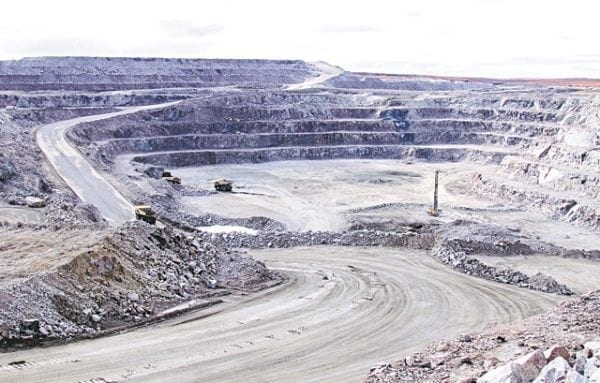The Northwest Territories' economy grew last year, thanks in large part to the completion of one full year of production at the Gahcho Kue diamond mine.

Activity at the Gahcho Kue diamond mine contributed significantly to the NWT economy in 2017.
The territory's gross domestic product – the value of goods and services produced in the NWT in one year – rose 5.2 per cent from 2016 to 2017, according to a May 2 report from the NWT Bureau of Statistics.
The NWT had the greatest growth of any jurisdiction in Canada after Nunavut, whose GDP jumped 13.3 per cent from 2016 to 2017.
Diamond mining increased 68.2 per cent as a result of activity at Gaucho Kue. De Beers, which operates the mine, says it produced 5.9 million carats in 2017.
Last year's mining boom was tempered somewhat by a 92.8 per cent drop in oil and gas extraction, says the GDP report, due to the end of production at Norman Wells early last year.
Jeff Barichello, the economic statistician at the NWT statistics bureau, says this territory has a “more volatile” economy because of it's small size.
“That's the nature of small resource economies,” he said on Tuesday.
The territory's economic growth last year outpaced Canada's as a whole, which rose 3.3 per cent.
Though prices for most staple items in Yellowknife increased over the last year, they rose less in this city than they did in Canada as a whole, according to a May 18 report from the bureau.
In April, the consumer price index (CPI) in Yellowknife was 1.8 per cent higher than one year earlier.
By contrast, Canada's CPI rose 2.2 per cent, Edmonton's went up 2.5 per cent and Iqaluit's increased 3.4 per cent.
The Bank of Canada describes the consumer price index as reflecting the retail price of a “representative shopping basket” of goods and services purchased by an average Canadian household. The basket carries prices for food, clothing, transportation, housing, furniture and recreation and paints in broad strokes a picture of the cost of living in Canada.
Compared with numbers from April 2017, shelter prices went up the most, by 3.9 per cent from last year.
This is partly because of increases in the prices of water, fuel and electricity, states the CPI report.
The prices of food from stores in Yellowknife in April, 2018 decreased slightly, by 1.2 per cent, compared with April of last year.
The price of food from stores also went down in Saskatchewan (0.9 per cent) and Prince Edward Island (0.1 per cent), according to data provided by Barichello.
Food prices fluctuate more than most other products, said Barichello.
Though prices in general tend to go up, he said, food prices rise and fall more often.
The general manager of the Yellowknife Co-op said he noticed lower prices last year for produce, meat and dry goods.
“Our suppliers have been telling us that we had deflation” in the prices of these items, Justin Nelson said on Tuesday.
Nelson could not say what caused the apparent deflation of certain foods in 2017.
The NWT Bureau of Statistics data bears this out.
Between April 2017 and April 2018, the prices of meat, dairy and eggs in Yellowknife dropped 3 per cent, fruit and nuts decreased 2.8 per cent and the price of fish and seafood went down 2.4 per cent.
Trevor Bayer, owner of Trevor's Your Independent Grocer on Old Airport Road, said prices at both Your Independent Grocer franchises in Yellowknife are set by Loblaw Companies Ltd. in Toronto.